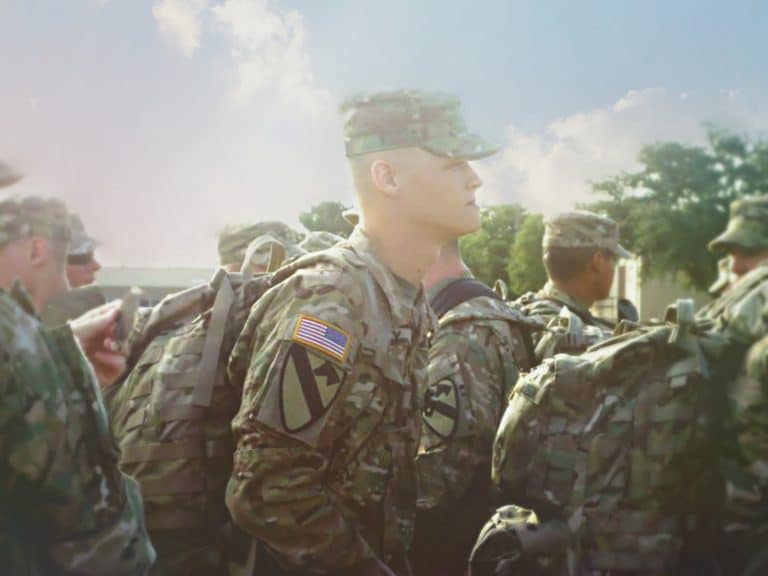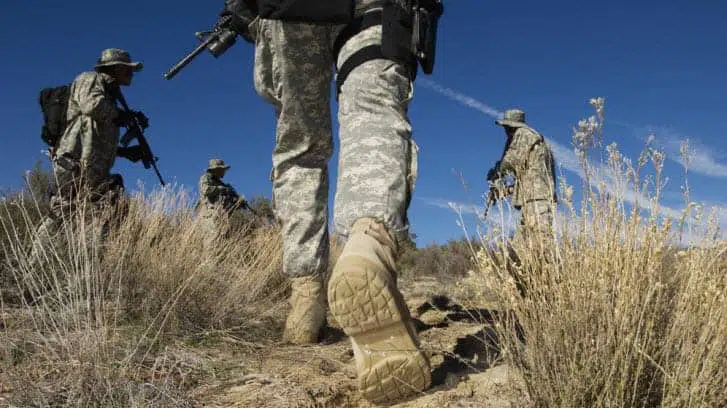All About Colorado Military Bases & History
Important Note: When you buy through our links, we may earn a commission. As an Amazon Associate we earn from qualifying purchases. Content, pricing, offers and availability are subject to change at any time - more info.
Colorado is a beautiful mountainous landlocked state with a rich history, it joined the long list of North American states in 1876, and over the years, it has been part of the military history of North America. Today Colorado hosts several air force bases and one U.S. army base. So what are Colorado’s military bases, and when were they started?
Colorado has six active military bases: Cheyenne Mountain Air Force Base, built in 1966; Academy Air Force Base, started in 1958; Peterson Air Force Base, constructed in 1942; Buckley Air Force Base, started in 1942; Schriever Air Force Base, began in 1985; and Fort Carson Army Base, built in 1941.
The air force bases in Colorado play a vital role in the American military, space, and aviation sectors. Colorado houses the second most requested army base for those in the United State Army. It is also home to the only Air Force Academy, whose specific duty is to train future Airmen and women. Each of the six Military bases in Colorado has its unique history and responsibilities; all play a vital role in the United States Army.
U.S. Military Bases In Colorado And Their Histories
As Colorado State is landlocked, none of its military bases are associated with the Coast Guard, Marines, or Navy. Instead, most of the military bases in Colorado are air force, with one of the most important being the Air Force Academy near Colorado Springs.
Let’s look at each of them to learn more about Colorado’s military bases.
Cheyenne Mountain Air Force Base, Colorado Springs
Since its inception, Cheyenne Mountain Air Force has collected data and intelligence using various means, including satellites, radars, and sensors. The base is a feat of construction built 600m into the mountainside. The parts found outside the mountain are constructed out of steel and concrete.
The personnel at Cheyenne Mountain Air Force operate their stations 24 hours a day, seven days a week, with only 200 Air Force, Army, Marine Corps, and Navy personnel deployed to this base at any given time.
History Of Cheyenne Mountain Air Force Base
A local commander suggested in 1956 to build an underground facility to replace the vulnerable Ent AFB in Colorado, which they deemed unsafe due to its open position above the ground. At the time, there was fear surrounding Russia’s launching of Sputnik I proving to the world that they could launch nuclear weapons across continents.
One year later, in response to Russia, the U.S. government created the NORAD, and the suggested mountain looked like the best place to house the new base. Its central location made it hard to reach, it had no recorded activity of any earthquakes in the area, and its mountain location made it a challenging target for missile attacks.
So in 1961, work began to build the new military base, and the site became fully operational in 1966. Since then, Cheyenne Mountain has undergone a series of improvements, the most important of which occurred in 1989. The most vital mission that Cheyenne Mountain took part in was Operation Desert Storm in the 90s, where they provided missile warning.
Air Force Academy Base, Colorado Springs
This Academy’s sole purpose is the training of future Airmen and women in the United States. You must be over 17 and under 23 years old to get accepted into this training academy. You must also have no dependents, including any children, even if you are not paying any child support at the time.
Training at the Air Force Academy is rigorous, especially the first year, which includes a five-week Basic Cadet Training course; this prestigious school follows strict military training. Although after the first year, students can expect to be given more freedom with multiple activities available, including picnics, fishing, informal and formal activities, military balls, etc.
History Of The Air Force Academy
For many years service members in the Air Force requested a unique academy to train future Airmen and women. In 1947 the Air Force was officially recognized as a military branch. Then, the idea of an Air Force school was put on the table and considered by those in power.
In 1954, Congress approved the start of the construction of the United States Air Force Academy, signed into effect by President Eisenhower on the 1st of April of that year. In 1958 the Academy’s construction was completed, and the students moved from their temporary base to the Academy grounds close to Colorado Springs. The first cadet wing only consisted of 1145 students, all of which were men.
It was only in 1976 when women were allowed to join the ranks of future Airmen students. The first female cadet class proved themselves when 97% of them graduated.
Peterson Air Force Base, Colorado Springs
The Peterson Air Force base is home to 21-st Wing, an enormous unit spread over six countries and multiple military bases. This unit is responsible for missile warnings and space control, collaborating closely with the North American Aerospace Defense Command.
Other units reside at this base, including the 721-st Mission Support Group and the 821-st Air Base Group. There are other multiple smaller units hosted there at different times.
Another primary function of this Air Force Base is providing runways to the local Colorado Springs Municipal Airport. This beneficial relationship arose from an agreement between local authorities and the army.
History Of The Peterson Air Force Base
In response to the ongoing hostilities in Europe, the United States Government ordered the Peterson Air Force Base construction in 1942 during a mass solidification process that saw the construction of multiple military bases to increase military power. The original mission for Peterson AFB was to provide photo reconnaissance training sessions.
In 1943 when the Air Force took over the base, several units and squadrons were deployed. After this, the new assignment was to build a school and train up personnel into bomber combatants and crew technicians for WW2.
Over the years, the mission and leadership of the base have changed multiple times. Since WW2, the base has closely collaborated with the local airport, resulting in relative inactivity during any of the 20th Century wars. However, it has always continued to help with the training of personnel.
Buckley Air Force Base, Aurora
The base’s primary occupants are those from the 460th Space Wing, whose mission is to defend the U.S. through protecting air operations, space operations and communications, and air space surveillance. The Wing is in command of the Mission Support, Operations, and Medical Group.
Buckley Air Force supports a large personnel population of approximately 88000, although only 109 are civilians and 1445 are Air Force members. In addition to the 460th Wing, the base houses the National Security Agency and the National Reconnaissance Office.
History Of Buckley Air Force Base
Buckley AFB began in 1942 and received its name from 1st Lieutenant John Buckley, who died in action during WW1. The original design for the base was to house the technical school for the Army Air Corps for crew members of the B-24 and B-17 bombers, as well as being a primary training base for the Army Air Corps.
When WW2 ended, and the Air Force became a separate military organization, it redesigned Buckley into an auxiliary field in 1946 for Lowry AFB. That same year, Lowry handed the base to the Air National Guard. Within a year of that handover, the Air National Guard handed it over to the Department of the Navy, with whom it stayed for the next 12 years.
After that, it reverted to the Air National Guard, who occupied it for the next 40 years. In 2000 the Air Force took over the base and added to it until it included housing, a fitness center, airmen’s dorms, BaseExchange, commissary, and housing for operations.
Schriever Air Force Base, Colorado Springs
Schriever Air Force Base was renamed Schriever Space Force Base in July 2021. This base houses the 50th Space Wing commanding and providing control for over 170 Department of Defense satellites. These satellites link to navigational, warning, and communications networks.
Also housed at this military base are the U.S. Air Force Warfare Center, the Missile Defense Integration and Operations Center, and the Global Positioning Systems’ main control point. Other units housed include the 21st Medical Group and the 310th Space Wing. More than 8100 personnel are on duty at the base, including guard/reserve personnel, active duty personnel, contractors, and civilian employees.
History Of The Schriever Air Force Base
Schriever Air Force Base is the only Air Force base named after an army veteran still living at the time of the naming. The base was initially called the Consolidated Space Operations Center (CSOC), but it was renamed the Falcon Air Force Station when it was still in its developmental stage. Then in June 1988, the base was renamed Falcon Air Force Base.
The first occupation of the base took place in September 1985 when 230 Air Force members, contractors, and civilian employees moved into its 12 new buildings. On the 30th of January 1992, the 50th Space Wing activated at Falcon AFB.
Then on the 5th of June 1998, the base was renamed to honor General Bernard Adolph Schriever, a retired General who helped pioneer the development of ballistic missile programs development in America.
Fort Carson Army Base, El Paso
Fort Carson Army Base is Colorado’s second most populous area and the second most requested duty station for those in the United States Army.
The Army Base is home to many different active duty units, including the 4th Infantry Division, 71st Ordnance Group (EOD), 4th Engineer Battalion, 10th Combat Support Hospital, 43rd Sustainment Brigade, 759th Military Police Battalion, 10th Special Forces Group, U.S. Air Force, and the 13th Air Support Operations Squadron.
History Of Fort Carson Army Base
Fort Carson, previously known as Camp Carson, was first established in 1941, shortly after the attack on Pearl Harbor. During WW2, it was a hub of activity and housed many different units, including Armor battalions, Italian Ordinance Groups, a Greek infantry company, mule packers, and cooks.
Between 1942 – 1956 Camp Carson was a training area for mule teams practicing for winter warfare. Over several years the camp housed approximately 9000 prisoners of war, including soldiers from Germany and Italy. In 1943 an internment center started operations at the base.
The end of WW2 saw the personnel housed at Camp Carson dwindle to around 600, but the start of the Korean War brought about expansion at the camp. They built training facilities to accommodate new units. In 1966 personnel at the base completed the construction on Butts Army Airfield, an aviation facility, allowing the facility to train Army aircraft at Fort Carson.
Final Thoughts On The Colorado Military Bases
All six of Colorado’s Military bases are important in their own right. From training up the future Airmen and women to monitoring satellites, defending U.S. air operations, monitoring space operations and communications, air space surveillance, and data and intelligence collection. All of these bases have played a role in the military history of the United States.






